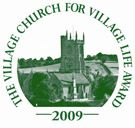Village Church for Village Life finalists
The search for this year’s rural parish church of the year continues, as we reveal the finalists for 2009


St Peter ad Vincula, Coggeshall, Essex
This church, which serves a community of 5,000, is in regular use for a variety of events, such as pantomimes, art exhibitions and quiz nights. In 2002, a discreet and architecturally sympathetic extension was added to the building to provide basic facilities. This houses a loo, a kitchen and two meeting rooms, which currently act as the venue for youth groups, a charity knitting group, mums-and-babies’ groups and yoga classes. The churchyard also helps bring the community together it’s cared for by a group of volunteers who have won several awards, including the Best Kept Churchyard in Essex title and a BBC Breathing Places award.
St Andrew’s, South Warnborough, Hampshire
This church has been adapted for use by the installation of a discreet kitchen and loo, and a small side extension on the north side of the church. A soundproof partition has been built between the side aisle and the nave. This provides either a snug separate room or extra seating for concerts and other village activities. If necessary, it can also be hired out to generate income. What lends this project particular interest is the manner in which it was undertaken. When the adaptations were proposed, a group of men formed the South Warnborough Gentlemen’s Working Club, and undertook much of the building work themselves, saving an estimated £35,000.
St Cuthbert’s, Clungunford, Shropshire
With no more than a sink and water supply to work with, the community of Clungunford has succeeded in turning the church into the focal point of the village. The open and airy church interior is used for children’s holiday clubs, art exhibitions, fairs, lectures and music events. In a village of only 300 people, where the post office, shop and pub have all gone, this is a wonderful example of the key position the church building can enjoy in village life. At St Cuthbert’s, the spacious churchyard plays its part as a location for outdoor activities, and an area has been purposefully set aside and developed as ‘God’s Acre’, where native species are encouraged and mowing times are set not to clash with wildflower seeding.
St Mary the Virgin, Stannington, Northumberland
Sign up for the Country Life Newsletter
Exquisite houses, the beauty of Nature, and how to get the most from your life, straight to your inbox.
When the parish approached the local council for help with reordering the church, it was agreed that if the building could be appropriately adapted, the council would supply and maintain computers for an online training centre. This IT centre is now housed in the adapted base of the church tower and is running very successfully. A new meeting room and kitchen have also been created at the west end of the church. At the same time, heating and lighting have been upgraded to save money and energy. IT users are charged £1 per week, which pays for the heating and lighting costs. Local groups can use the meeting room for free and outside groups pay £5 an hour.
St James the Great, Aslackby, Lincolnshire
Realising that their centrally located church had potential for a wider use, but not having the funds to alter the fabric in any way, the villagers of Aslackby have transformed their church by experiment. Over a five-year trial period, they have put the building to every practicable use they can imagine. It now serves as a regular venue for concerts, family activity days, talks and presentations. It’s also home to a film society with a membership in a village of about 100 houses of more than 200. Following this success, plans are under way to install basic amenities to ensure that these events carry on in the future.
St Bega’s, Bassenthwaite, Cumbria
Standing in picturesque proximity to Bassenthwaite Lake, St Bega’s was one of the smallest churches to be entered this year. Following consultation with the local community which numbers about 400 people part of the church was reordered to make it better suited to a wider use. Now, after the removal of pews from a small area of the interior, the installation of a new organ and the limited adaptation of the church fabric for a small kitchen, the church is used for concerts and lectures, plus a twice-monthly Fairtrade shop, and by school groups and visitors to the area.
Country Life is unlike any other magazine: the only glossy weekly on the newsstand and the only magazine that has been guest-edited by HRH The King not once, but twice. It is a celebration of modern rural life and all its diverse joys and pleasures — that was first published in Queen Victoria's Diamond Jubilee year. Our eclectic mixture of witty and informative content — from the most up-to-date property news and commentary and a coveted glimpse inside some of the UK's best houses and gardens, to gardening, the arts and interior design, written by experts in their field — still cannot be found in print or online, anywhere else.
-
 The century-old enamelling technique used to create Van Cleef's lucky ladybird brooch — which has something in common with Country Life
The century-old enamelling technique used to create Van Cleef's lucky ladybird brooch — which has something in common with Country LifeThe technique used in the jeweller's Geneva workshop has been put to good use in its latest creation.
By Hetty Lintell Published
-
 ‘The best sleep in the sky’: What it’s like to fly in United’s Polaris cabin, approved by American icon Martha Stewart
‘The best sleep in the sky’: What it’s like to fly in United’s Polaris cabin, approved by American icon Martha StewartUnited’s Business Class cabin goes by the name Polaris and Martha Stewart is a fan. So, how does it fare?
By Rosie Paterson Published
